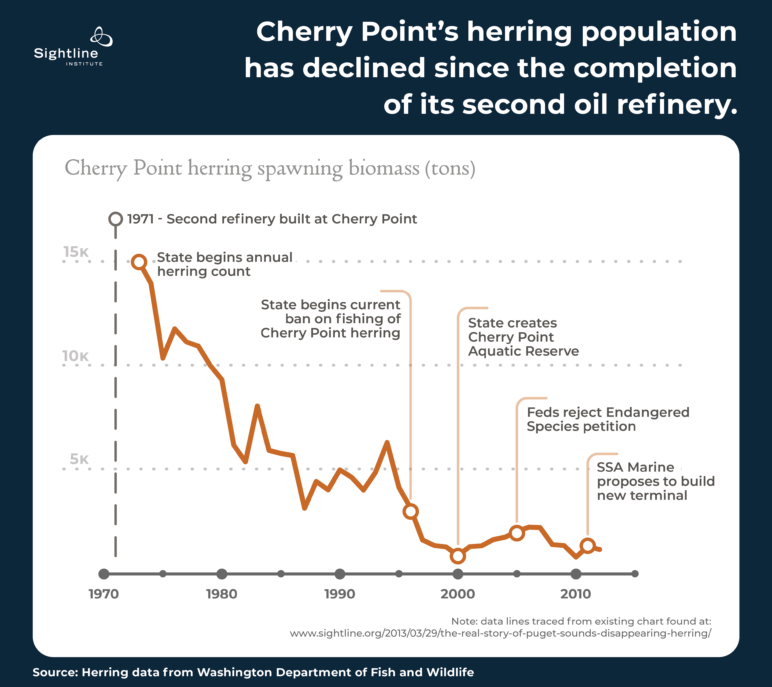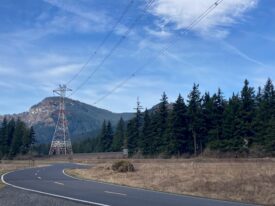About 90 percent of the petroleum products consumed in Cascadia—our gasoline, diesel, jet fuel, and more—are refined at five refineries sitting on the shores of the Salish Sea. These refineries are super polluters. They comprise four of the top eight sources of carbon pollution in the state and are responsible for over 26 percent of Washington state’s greenhouse gas emissions from large industrial facilities. And, as will be shown in this chapter, Washington’s oil refineries have a checkered past of violating the regulations designed to protect their workers, the environment, and people living in their vicinity.
The coming decades will bring increasingly volatile oil markets as well as promising boosts in energy efficiency, vehicle electrification, and a shift to cheaper clean energy. As demand for oil drops, Puget Sound refinery communities can plan ahead for a smooth transition—protecting workers, local economies, and the environment to build a thriving and resilient future. This article is part of a special series on the issue.
Pollution occurs in every phase of the oil refining process. In this series, we analyze the impacts of pollution in three categories: direct pollution from the refinery operations themselves; “upstream” and “downstream” pollution from transporting crude oil and refined products;1 and indirect pollution from consuming the refineries’ products. It’s important to consider all three categories because Northwest refineries do not exist in isolation. Rather, they sit at the center of a sprawling web of petroleum infrastructure. In this chapter, we discuss the impacts of direct pollution of refinery operations.
Air Pollution
Oil refineries are major sources of toxic air pollutants, including cancer-causing benzene, particulate matter, nitrogen oxides, carbon monoxide, and sulfur dioxide. Refinery pollutants are heavily concentrated near frontline communities in Anacortes, Ferndale, and Tacoma, including the tribal reservations of the Lummi, Swinomish, and Puyallup peoples. Studies show that people living within 10 miles of a refinery are at higher risk of developing a wide range of health issues, including asthma, cancers, neurological and cardiovascular damage, and blood disorders. Refinery pollution contributes to existing racial and socio-economic health disparities in Washington, such as higher asthma prevalence among Black and Native American people.
A few examples illustrate how Washington refineries regularly exceed air pollution regulations, contributing even more to adverse health impacts to Washington residents living nearby. Similar to the way a significant portion of the industry’s tax bill goes toward mitigating the problems it creates, most of the fines levied against refineries for pollution violations actually go toward upgrading refinery equipment and processes that should have already happened. And compared to the refining industry’s massive profits ($2 billion annually in recent years!), many of the fines paid are paltry.
In 2005, ConocoPhillips was fined $4.5 million for Clean Air Act violations of sulfur emissions at nine of its refineries, including its Ferndale refinery. Phillips was also required to spend $525 million to upgrade its facilities to come into compliance with federal law.
In 2011, US Oil and Refining was fined $230,000 for Clean Air Act violations, including failing to report and track cancer causing benzene. US Oil had to spend an additional $746,000 on facility upgrades to control asphalt vapors containing particulate pollution, which can cause and exacerbate asthma.
In 2016, Tesoro settled alleged Clean Air Act pollution violations at six refineries, including its Anacortes facility for benzene violations, for $425 million. Almost the entirety of the settlement, $403 million, went toward installing and operating pollution control equipment. The remaining $22 million was split into two pots. First, Tesoro was required to spend $12 million on projects to improve public health in the communities living around their refineries. Second, it paid a civil penalty of $10 million for its alleged violations, $250,000 of which went to the Northwest Clean Air Agency.
In 2016, the Shell Refinery at Anacortes was fined $133,000 by the Northwest Clean Air Agency for a 2015 violation of shutdown and decontamination procedures that resulted in a release of chemicals into the atmosphere, including benzene, which causes cancer. The US Environmental Protection Agency also fined Shell $191,000 for the same incident for violations of the Clean Air Act. While Shell initially claimed that no detectable levels of harmful pollution were found after the release of chemical odors, wind carried the chemical release over the nearby Swinomish Indian Tribal Community reservation. The Swinomish reported 550 people affected by the release, 12 of whom sought medical treatment with five admitted to an emergency room or hospital. Affected people reported symptoms similar to those described above from common pollutants: irritation of eyes, throat and lungs, headaches, nausea, fatigue, and loss of appetite.
The Northwest Clean Air Agency fined the Shell Refinery for $60,000 in 2020 for a similar flaring incident, which again affected the Swinomish. The Clean Air Agency’s news release notes that “[d]escriptions of the odors and their impacts reported by area resident… were similar to those received by NWCAA following a Shell flare release in February 2015.”
Incidents like these are unfortunately not rare. A study of a community in Italy showed that people living near oil refineries have higher rates of cancer—and die of cancer more frequently—than people living farther from oil refineries. A study of a Taiwanese community in the vicinity of an oil refinery and coal power plant found similar rates of increased cancer among nearby residents. In addition to cancer, a study of a refinery-adjacent community in Jordan found that residents were more likely to have skin problems and report asthma. And refineries in the US, including Puget Sound refineries, regularly violate air pollution limits of pollutants like benzene.
Other forms of air pollution from the refinery operations go well beyond nearby communities to degrade the Northwest’s most prized wild places. The US National Park Service has used state-of-the-art air monitoring equipment to demonstrate that the BP Refinery is one of the biggest sources of air pollution at Olympic National Park. That single facility is responsible for an average of 57 days of “impaired” air quality at Washington’s sole World Heritage Site—that is, days when pollution from the refinery creates haze, reduces visibility, and diminishes the visual crispness of colors. And modeling indicates that a recent small expansion at the BP refinery would have bumped up that figure to 70 days per year, on average. The BP refinery affects the North Cascades National Park too, impairing air quality on an average of 38 days each year. And in addition to air quality impacts, the National Park Service worries that continued refinery growth will result in increased NOx emissions that would, in turn, increase acid deposition in the North Cascades, potentially upsetting fragile ecosystems.
Water Pollution
Refineries also take a toll on their land and nearby waterways. In the course of normal operations, refineries generate large volumes of wastewater.2
Even after treating the wastewater, there may still remain a variety of pollutants, including sulfides, ammonia, and other oil residuals. The EPA sets limits for the concentration of pollutants that can remain in treated wastewater. These limits, however, are based on what is technologically feasible, not what may be damaging to the environment. Washington’s Department of Ecology enforces state wastewater regulations, which are often more stringent than the federal standards.3 Even with stringent regulations, pollutants from discharges from years past may linger and build up in the water.
Pollution in Fidalgo Bay, home to the two Anacortes refineries, has a deep meaning to the Swinomish Tribe. Swinomish elders are fond of saying that, “when the tide is out, the table is set,” referring to the extensive tide flats in Fidalgo Bay that support a variety of marine life including herring, clams, and crab, and other foods. But it is no longer safe to eat. In 2010, the Washington Department of Health concluded that eating seafood from Fidalgo Bay at “tribal scenario consumption rates, exposures are above levels known to result in non-cancer and cancer harmful health effects.” And, as a result of pollution both from refineries and historical industries, the Department of Ecology has placed Fidalgo Bay into a toxics cleanup program.
The true cultural and health impact of pollution in Fidalgo Bay is driven home in March Point, a 2008 documentary produced by Longhouse Media, that follows three Swinomish teens as they learn about the refining industry in Anacortes, showcasing the importance of shellfish consumption to Swinomish culture and identity. In the film, the teens dig for clams along the shore of March Point, where the refineries sit, and send the clams to a lab for testing—and the results show that they are full of toxins. These toxins affect health outcomes: the documentary shows a doctor at the Swinomish Tribal Health Clinic worrying about her patients developing cancer or other illnesses because many of them eat fish every day, or multiple times per day.
Impact on Local Wildlife
Refineries harm their local ecology in other ways too. For just one example, consider the case of the once-prolific Cherry Point herring in north Puget Sound. Before the refineries were built there, Cherry Point herring were the largest stock in Puget Sound. Almost immediately after the BP refinery opened at the site in 1971, the genetically distinct local herring stock plummeted. The number of spawning fish plummeted 92 percent from 1973 to 2012, according to data from the Washington Department of Fish and Wildlife. The herring population has yet to recover.
 Based on spawning surveys, scientists know that in 1981, Cherry Point herring spawned along more than 60 kilometers of shoreline. By 2004, the fish used less than 22 kilometers. The shift is worrisome, whether it’s the result of the fish population getting smaller or because of human activity in the area. A 2006 report from the National Marine Fisheries Service concluded that the shrinking spawning area “increases risks” from man-made insults such as “oil spills and contaminant releases near Cherry Point.”
Based on spawning surveys, scientists know that in 1981, Cherry Point herring spawned along more than 60 kilometers of shoreline. By 2004, the fish used less than 22 kilometers. The shift is worrisome, whether it’s the result of the fish population getting smaller or because of human activity in the area. A 2006 report from the National Marine Fisheries Service concluded that the shrinking spawning area “increases risks” from man-made insults such as “oil spills and contaminant releases near Cherry Point.”
Refineries pollute the air and water in their immediate vicinity, harming people’s health and interrupting their lives, sometimes in profound ways. Unfortunately, the direct impacts in the nearby refineries is only the tip of the iceberg for pollution that can be attributed to these super-polluters. Describing the full extent of the harm refineries pose will continue through the next four chapters of this series.
This article benefited from past research by Lisa Stiffler and Britany Kee’ ya aa. Lindley.










